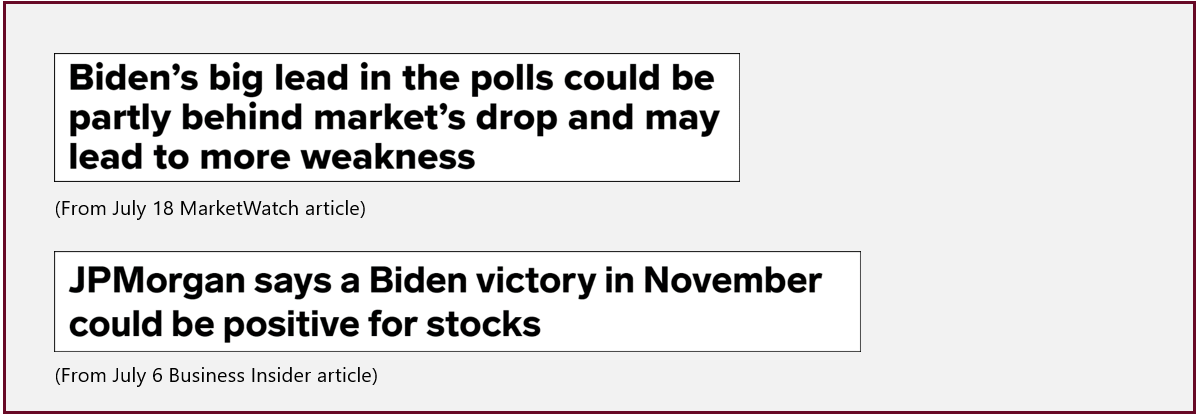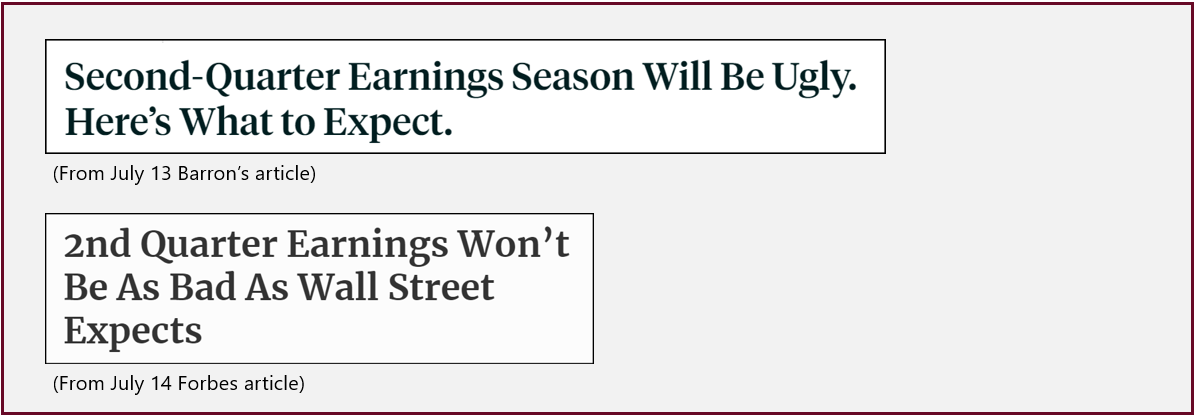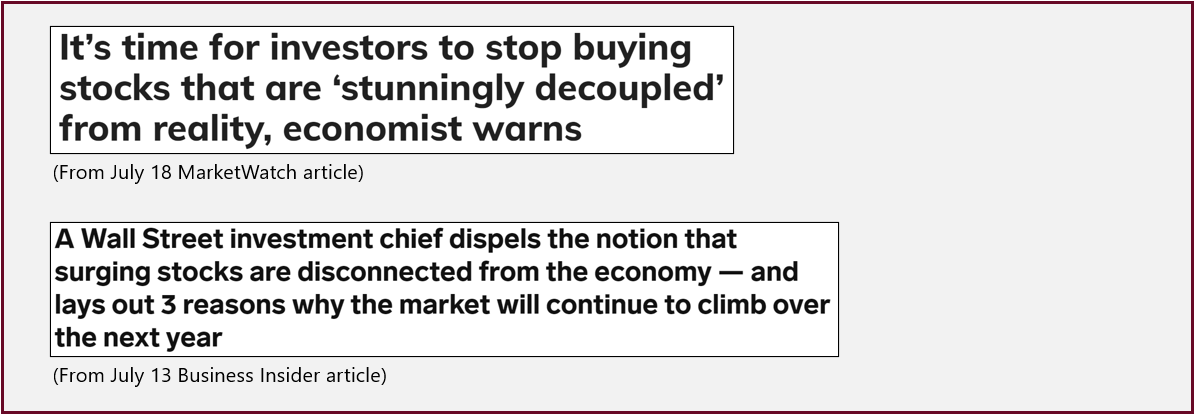The old investing adage “buy low, sell high” can certainly be a lucrative strategy if done correctly and with precision. However, the perpetually unpredictable nature of the markets makes it nearly impossible to consistently identify when it is the right time to “get in” and “get out” of the market.
In a world of real-time market updates and news, the instinct to buy low and sell high can cause investors to have knee-jerk reactions to headlines and Tweets. This has certainly been the case since the outset of the COVID-19 pandemic in March, when historic levels of volatility triggered one of the fastest sell-offs in history. In the last three months, the significant market rebound has led a cross-section of investors—ranging from day traders to hedge funds—to jump back into U.S. equities and fixed income.
Despite the market euphoria, we are currently facing unprecedented uncertainty:
Given the current environment, making investment decisions based on news headlines is incredibly illogical and risky. Helping investors keep a calm head and avoid emotional decisions dictated by the headlines is of paramount importance.
Making matters worse is how market “experts” can’t even agree with one another on how things are trending hour-to-hour, resulting in market timing woes.
When it comes to the Q3-Q4 outlook, pundits are far apart. When it comes to key questions, such as economic recovery, it is impossible to say for certain whether the U.S. will experience a V-shaped or W-shaped rebound. Even Federal Reserve officials have conflicting opinions on whether the economy will recover from the COVID-19 crisis in the near-term.
In two articles published on the same day, there appears to be a major disparity in the economic outlook coming from various Fed officials. As one set of Fed officials warned that a surge in COVID-19 across the U.S. could cause economic conditions to worsen, the St. Louis Fed president had a more upbeat outlook and expressed confidence that the economy could adjust.

On the corporate earnings front, many analysts have braced for poor results given that Q2 earnings were the first set of earnings since the U.S. entered a recession. Barron’s reported that second-quarter earnings would be dismal. However, a Forbes contributor aimed to disprove that theory, writing that Wall Street was focused on “overly pessimistic” numbers.

Top investment officers and strategists have also clashed when it comes to opinions. Earlier this month, Allianz economic advisor Mohamed El-Erian asserted that certain stocks were “severely decoupled” from the economy. On the contrary, Northwestern Mutual Chief Investment Strategist Brent Schutte explained why he disagrees with the notion that the stock market is disconnected from the current reality.

As for the election, CNBC reported that Wall Street is fearful that a Democratic victory in the 2020 presidential election will drag down the stock market. Less than two weeks later, Business Insider cited analysis from JPMorgan suggesting that other Democratic policy proposals would be “net positive for S&P 500 earnings and largely offset the corporate tax headwind.”

Relying on news headlines to time the markets is an ill-advised investment approach. Advisors need to be the guiding hand of reason in times like these and remind their clients of this. If any doubts exist, just look at the contradictions thrown back and forth over the past few months.
At Swan, our unique investment philosophy avoids stock picking and market timing, and instead employs a strategy that is focused on helping long-term investors grow and preserve their wealth. Our Defined Risk Strategy (DRS) is designed to deliver consistent rolling returns amid an ever-changing market landscape. The DRS’ time-tested approach has helped clients navigate and even capitalize on bear markets over the past two decades.
With the DRS, clients’ capital is always invested in the market through low-cost equity ETFs. That way, they are never “missing out” on growth if the market experiences any gains. At the same time, the DRS seeks to mitigate risk by remaining always hedged, which mitigates the risks to irreplaceable capital in case the market plummets due to unforeseen events.
We are living in a strange and trying time. Uncertainty abounds. Divergent forecasts from industry experts compound the challenges long-term investors are facing. To address uncertain or tumultuous markets, it’s best to focus on one’s long-term plan and reduce the noise. Then utilize strategies that can seek consistent, more predictable rolling returns through full market cycles. At Swan, that is exactly what we seek to deliver.
Swan Global Investments, LLC is a SEC registered Investment Advisor that specializes in managing money using the proprietary Defined Risk Strategy (“DRS”). SEC registration does not denote any special training or qualification conferred by the SEC. Swan offers and manages the DRS for investors including individuals, institutions and other investment advisor firms. Any historical numbers, awards and recognitions presented are based on the performance of a (GIPS®) composite, Swan’s DRS Select Composite, which includes non-qualified discretionary accounts invested in since inception, July 1997, and are net of fees and expenses. Swan claims compliance with the Global Investment Performance Standards (GIPS®).
All Swan products utilize the Defined Risk Strategy (“DRS”), but may vary by asset class, regulatory offering type, etc. Accordingly, all Swan DRS product offerings will have different performance results due to offering differences and comparing results among the Swan products and composites may be of limited use. All data used herein; including the statistical information, verification and performance reports are available upon request. The S&P 500 Index is a market cap weighted index of 500 widely held stocks often used as a proxy for the overall U.S. equity market. Indexes are unmanaged and have no fees or expenses. An investment cannot be made directly in an index. Swan’s investments may consist of securities which vary significantly from those in the benchmark indexes listed above and performance calculation methods may not be entirely comparable. Accordingly, comparing results shown to those of such indexes may be of limited use. The adviser’s dependence on its DRS process and judgments about the attractiveness, value and potential appreciation of particular ETFs and options in which the adviser invests or writes may prove to be incorrect and may not produce the desired results. There is no guarantee any investment or the DRS will meet its objectives. All investments involve the risk of potential investment losses as well as the potential for investment gains. Prior performance is not a guarantee of future results and there can be no assurance, and investors should not assume, that future performance will be comparable to past performance. All investment strategies have the potential for profit or loss. Further information is available upon request by contacting the company directly at 970-382-8901 or www.swanglobalinvestments.com. 377-SGI-083120